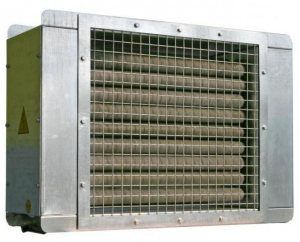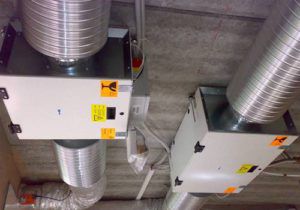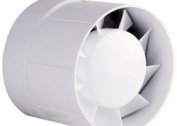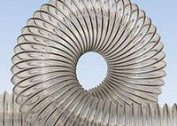Providing fresh air access to housing in our time is quite simple. The easiest way to do this is to install flow ventilation with a fan installed in it. In this case, on hot summer days, the room will always have clean cool air.
But what to do in the winter, when the air supplied through the ventilation is too cold? But for this case there is a solution - it is necessary to install a heater in the ventilation duct, which will provide heating of the air that is supplied from the street.
A heater is a device that heats the air by touching it with the surface of the heating elements, the amount of which may be different.
Types of air heaters
The heaters that can be used in ventilation systems differ in power, performance, type of coolant and some other parameters. The most widespread are two main types:
- electric;
- water.
As the name implies, such heating devices differ from each other as a heat source for heating air.
Electrical devices
 Electric heaters for fresh air ventilation are very effective, but quite expensive heating devices. The temperature increase in the ventilation duct is carried out as a result of air contact with incandescent spirals or plates made of refractory types of metals.
Electric heaters for fresh air ventilation are very effective, but quite expensive heating devices. The temperature increase in the ventilation duct is carried out as a result of air contact with incandescent spirals or plates made of refractory types of metals.
The temperature increase of the heating elements in this case occurs due to a change in the electrical resistance of the heaters. This requires a lot of electrical energy.
The degree of heating of a spiral or plate is directly proportional to the strength of the current that flows through the element. By increasing the voltage, it is possible to reduce the current strength without changing the electric power.
Despite significant energy costs, electric heaters are compact in size and easy to install.
Advantages and disadvantages of electric heaters
Among the main advantages that characterize an electric air heater, it is worth highlighting the following.
Simple installation process. So, bringing a cable to the heater is much easier than circulating water or another coolant inside it.
You do not have to worry about providing thermal insulation for the wiring. The power loss in the cable as a result of electrical resistance is much lower than the heat loss in any pipeline with a coolant.
Easy adjustment of suitable air temperature. In order to be able to set the temperature of the air supplied to the room at the required level, it is enough to install a simple temperature sensor in the power circuit of the heating device. In the case of a water heater, coordination of the boiler power, temperature of the coolant and air will be required.
However, the electric type of devices has its drawbacks. First of all, this is the cost of the device, which is higher in comparison with water counterparts. So, in the case of approximately the same power level, the price of an electric air heater will be about 2 times higher than a device with a liquid coolant.
Sufficiently high energy costs. So, to ensure air heating in the ventilation system of even a small room, the cost of electricity will be significant.
Given that in winter, air heaters operate almost without interruptions, there is a high probability of overheating of the device. In the case of devices that run on electrical energy, this can lead to serious consequences. Therefore, heaters for ventilation of this type must be equipped with a reliable system of protection against overheating.
Water devices
 The second type of ventilation heaters - water, provides an increase in the temperature of the air supplied to the ventilation duct due to the transfer of thermal energy from the coolant that circulates inside the radiator of the device.
The second type of ventilation heaters - water, provides an increase in the temperature of the air supplied to the ventilation duct due to the transfer of thermal energy from the coolant that circulates inside the radiator of the device.
Liquid as an air heater is in no way inferior to electrical analogues, but it does not require large energy consumption.
But unlike the electric type device, water systems are quite difficult to install, so it is quite difficult to carry out their installation on their own.
Pros and cons of water heaters
Among the advantages that water air heaters have in ventilation systems, the most important is the high efficiency of use even in large areas.
This is ensured by the design features of the device, since the heating of air in it occurs in a plane perpendicular to the air flow.
The most important drawback of a water heater is the high likelihood of freezing of the device in severe frosts, since the principle of its operation is based on the flow of water inside the radiator. That is why heaters of this kind should have protection against possible icing.
Device Performance Materials
In the case of electroheaters, there are few options for using materials. Most often, steel or aluminum fins of heating elements are found. Sometimes a heating system is also used, the main element of which is an open tungsten filament.
In the case of water heaters, the following options are used:
- steel pipe with fins made of the same material. A similar design is the cheapest;
- steel pipes and aluminum fins. This design guarantees higher heat transfer due to the excellent thermal conductivity of aluminum in comparison with steel;
- bimetallic heat exchangers with copper pipe and aluminum fins. This option guarantees the highest level of heat transfer.
Features of choosing electric heaters
In the event that an electric type air heater will be used in the ventilation system, the device should be selected according to its temperature at the outlet and inlet, as well as the level of air flow.
Most manufacturers in the documentation for their products indicate electrical power and air consumption. In this case, the choice of the device does not raise any questions. But it is also important to provide support for the minimum allowable air flow. If this requirement is ignored, the heating element of the electric air heater can quickly fail.
Thus, the air heater in the ventilation system provides the room with an influx of fresh and, most importantly, warm air. At the same time, there are two main types of heating elements - water and electric.
In the case of a small area, it is more advisable to install an electric type device, since they differ in simple installation and compact size. If the room is large, the best choice is to install a water heater, which is characterized by low energy consumption in comparison with similar devices powered by electricity.



